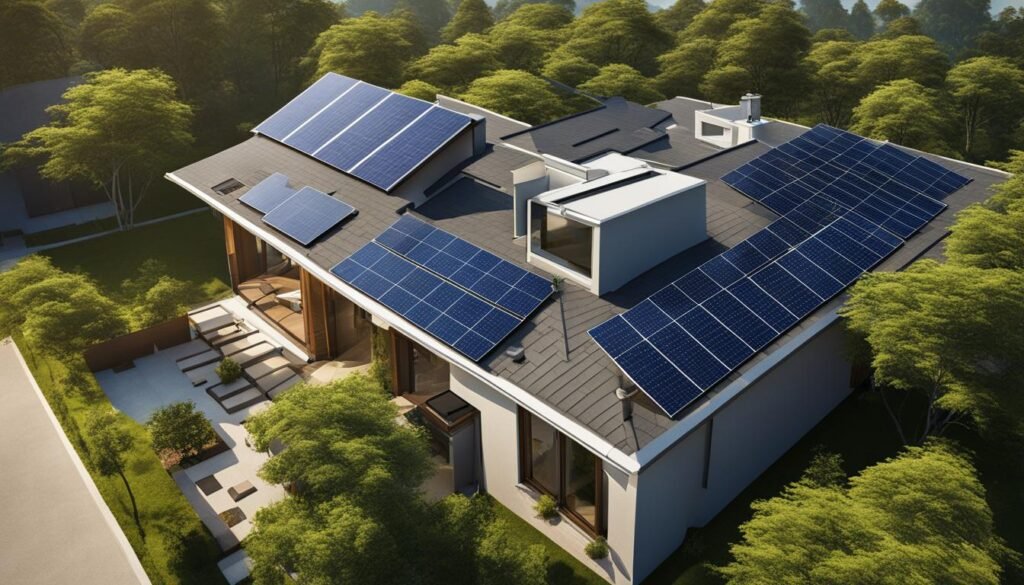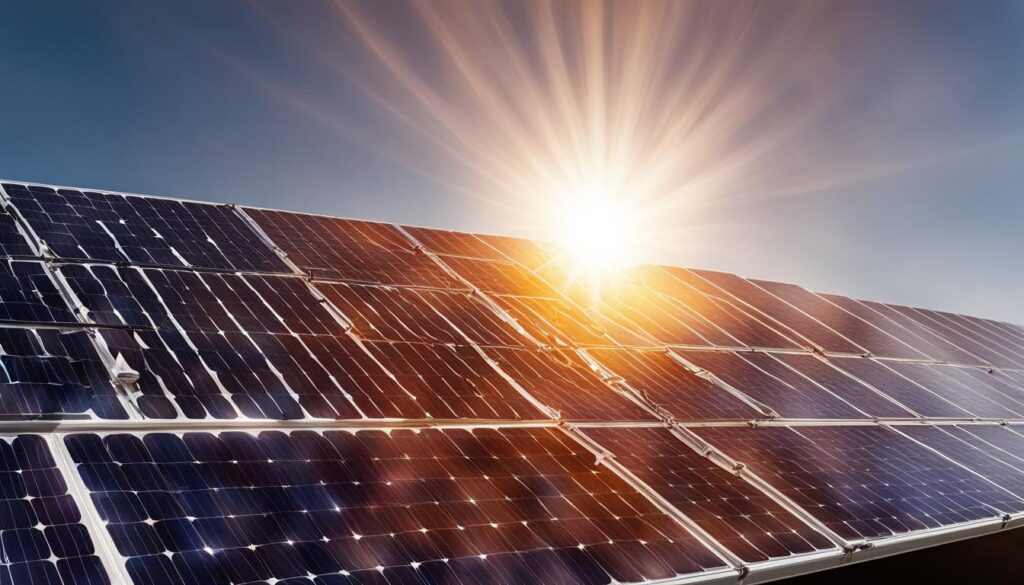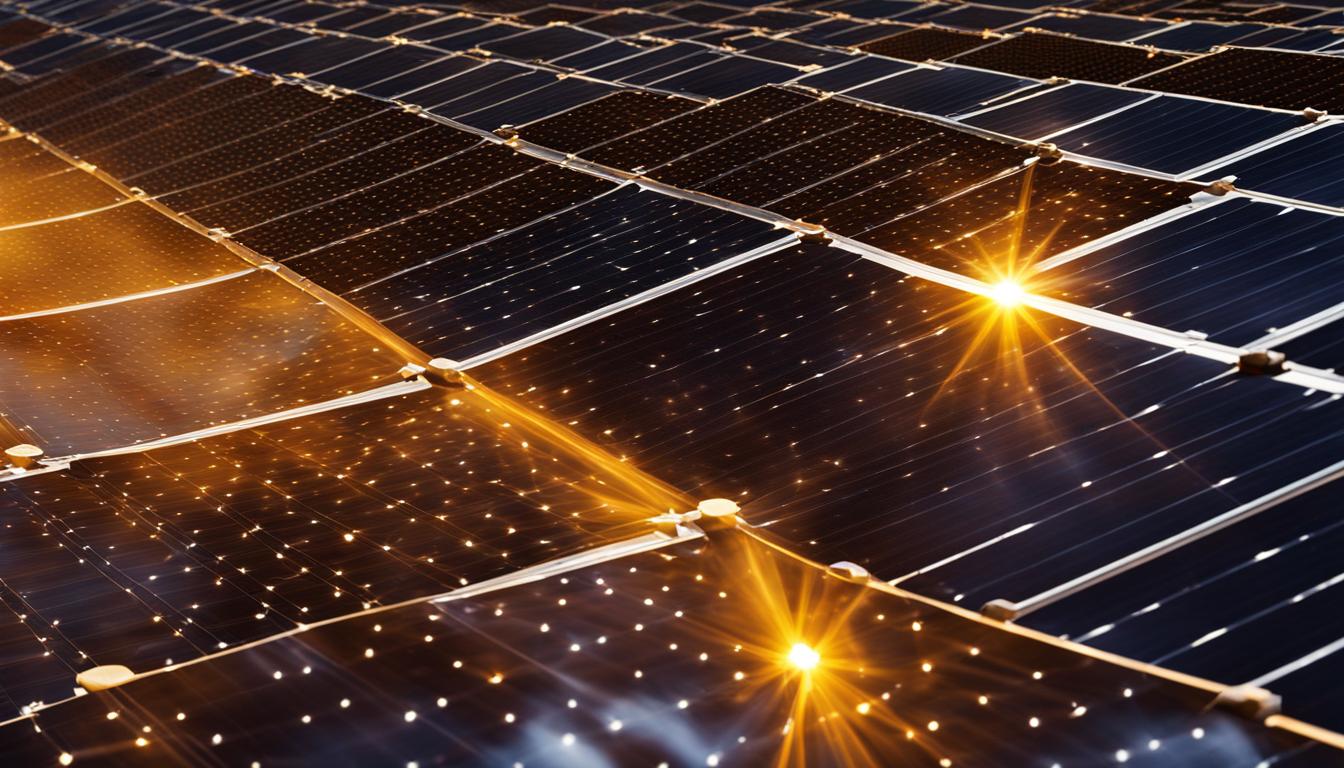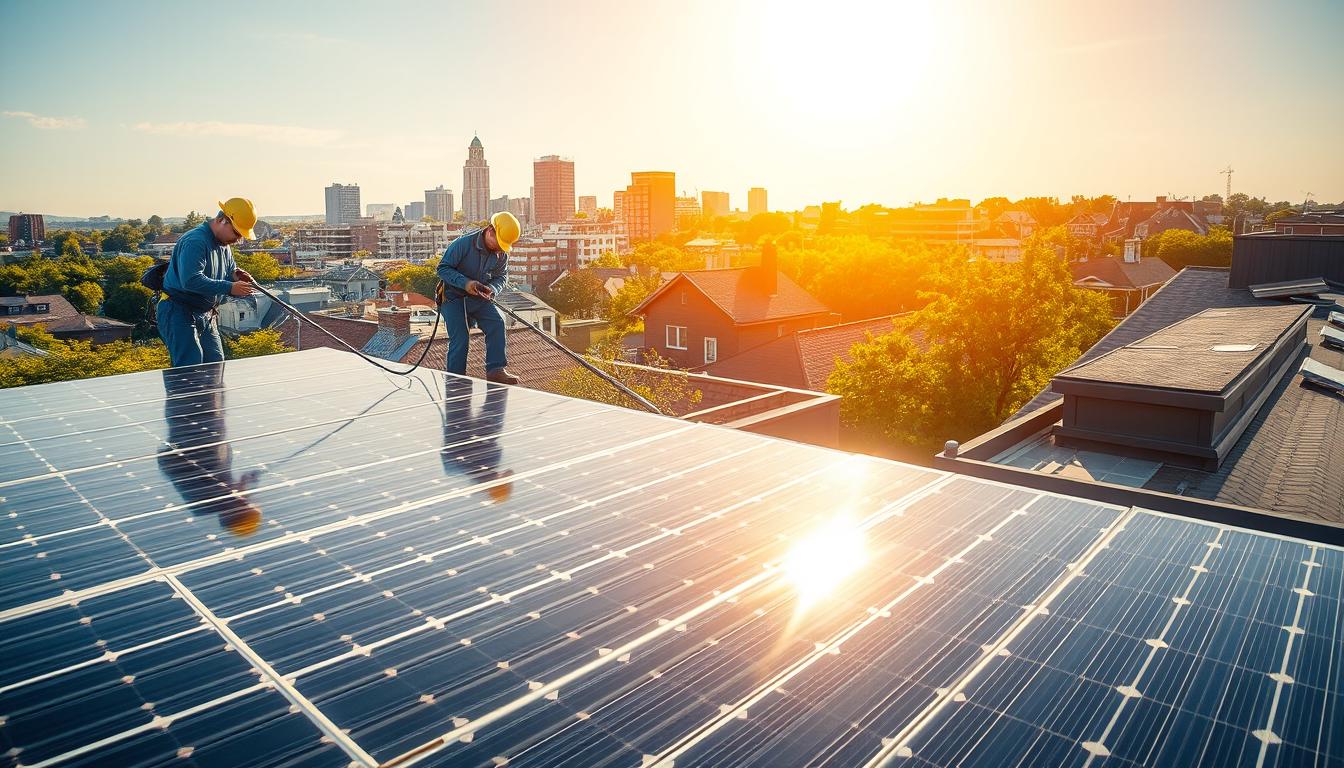Ever basked in the sunshine and wondered, “How does this warmth above get transformed into the cool electricity below that powers my trusty coffee maker?” Well, I’m here to demystify that solar energy generation process for you. It’s like nature’s magic trick—sunlight in, electricity out, but with science as the magician’s wand! Behold the photoelectric dance performance of solar panels on rooftops, turning nature’s sunny smiles into the electric tango that runs our modern lives. Revealing this spectacle involves understanding how solar panels generate electricity—a process so brilliantly simple yet ingeniously complex.
The process of solar panel electricity production kicks off with a game of microscopic tag where photons—the sun’s messengers—knock into silicon cells and stir up electrons, those tiny particles with a zest for freedom. Imagine a rock concert where the sun’s rays are the opening act, and the silicon-filled photovoltaic cells are fans, jumping at every beat. This energy mosh pit causes a current to flow, creating the type of rock ‘n’ roll that keeps our lights flickering and our playlists spinning.
Key Takeaways
- Solar panels convert sunlight to electricity using silicon’s photoelectric tendencies.
- The solar energy generation process is a carbon-neutral concert headlined by the sun.
- Every solar panel is a mini power plant on your roof, silently producing energy from daylight.
- Greenhouse gas emissions take a backseat as solar panel electricity production takes the wheel.
- Electrons released by photovoltaic cells are tiny but mighty warriors against traditional energy dependency.
- Even on cloudy days, solar panels prove their worth, ensuring the energy show goes on.
The Dawn of Solar: A Brief History Unveiled
My fellow sunshine enthusiasts, let’s embark on a journey through time, tracing the evolution of the solar power generation process from its ancient beginnings to the high-tech rooftops we see today. Ready to bask in the knowledge of the past? Here we go!
The Ancient Roots and Modern Discovery of Photovoltaics
Imagine this: It’s the 7th century B.C., and somewhere, someone just figured out they could concentrate sunlight to spark a flame. Fast forward to the Grecian and Roman empires, where shiny objects called mirrors turned up the heat in religious practices. Yet, it wasn’t until 1839 that French physicist Edmond Becquerel had his eureka moment with the photovoltaic effect beneath the Parisian sun. This discovery laid the foundation for everything that makes us solar-savvy today.
From Silicon Breakthrough to Spacecraft: Evolution of Solar Cells
Who knew a sliver of silicon would kickstart a revolution? By 1954, Bell Labs plugged into the future with the first solar cell capable of powering our everyday gear. Now, the solar panel energy conversion isn’t just about lighting up homes; it’s about powering space exploration. Yes, that’s right, spacecraft above our heads, all thanks to the relentless progress in the photovoltaic electricity generation process.
As I tip my hat to the ingenuity of the past, I can’t help but beam with pride for the shining legacy that solar power holds for our future. Onward to a brighter, greener tomorrow!
How Do Solar Panels Generate Electricity?
Let’s dig a little deeper into the marvel of solar energy conversion to electricity. As I catch a bit of sunlight on my face, it’s exciting to think that the same warmth touching my skin also powers up countless homes across the country. The transformation from mere photons to useful electricity is not just an act of science; it’s an art in its own right.
Introduction to the Photovoltaic Process
I like to picture it as a quiet ballet of electrons—courtesy of our dedicated solar cells. When sunlight hits my hands, I just feel heat, but when it hits a solar panel’s cells, it’s showtime. The solar cell electricity generation begins as they absorb sunlight and start their dance, knocking electrons free in a waltz that’s fueled by solar power.

Anatomy of a Solar Panel: Silicon Cells and Electric Fields
A solar panel is essentially a flat-lay gourmet sandwich—a layer of silicon cells fitted in a metal frame, snug under a sheet of glass. These aren’t just any silicon cells; they’re oppositely charged, just waiting for the sunlight to be their dance floor. As the light descends, an electric field wakes up in quiet anticipation. The motley crew of released electrons, influenced by this field, begins to move with purpose, generating what we know as solar panel power generation.
As each ray of sunlight liberates countless electrons, a current is born and progresses through the circuit, eager to be of use.
This, my fellow solar enthusiasts, is the behind-the-scenes action that delivers to us the splendor of electricity without the guilt trip of increasing carbon footprints.
- Photon’s Arrival: The curtain rises with photons reaching the silicon cell.
- Electrons Get Groovy: The electric field conducts the electron orchestra.
- Flow of Current: Electrons hustle along the circuit, creating an electric current.
- AC Conversion: An inverter coaxes the current to switch up its moves from DC to AC.
With the daily sun as our steadfast partner, we’re orchestrating a symphony of sustainable electricity generation, one solar panel at a time.
Decoding the Solar Panel Technology
When I think about the marvels of modern technology, solar panels certainly top the list. The solar energy generation process is literally powered by the universe’s largest star—the sun. Isn’t that something? But let’s dive deeper into these wafers of wonder.
Silicon, my dear friends, is more than just a Valley. It’s the bedrock of photovoltaic electricity generation process. The craft behind solar panels is no less than a magician’s spell, carefully concocted to convert those lucid beams of sunlight into crisp, usable electricity.
I’ve witnessed those expansive arrays myself, all lined like soldiers on a salute across rooftops, drinking in the sunshine like it’s their life’s potion. This is the solar energy conversion to electricity at its finest, making use of every possible ray, and even on those overcast days when sunlight plays hide and seek, these panels keep at it, albeit with modest output.
Let me throw a spotlight on China for a moment. They’re like the solar-powered superheroes of our planet, leading the charge in harnessing those golden rays for electricity generation. The US, amongst others, follows suit, picking up the pace in this vital race.
Let’s lay out the data on the table, shall we? There’s nothing like a good ol’ table to crystallize those figures:
| Factor | Impact on Solar Energy Generation Process |
|---|---|
| Material Used | Silicon, durable and potent in converting sunlight |
| Placement | Strategic, often on rooftops/open spaces for maximum exposure |
| Output on Cloudy Days | Reduced, but still operational due to sophisticated panel design |
| Global Leadership | China leads, with the US and other countries energetically following |
Now isn’t that as clear as a sunny day? The essence of the solar-powered narrative is all about precision crafting and strategic placement, enchanting photons into a dance of electricity. And as I’ve revealed, it’s quite the global endeavor, isn’t it?
Transforming Sunlight to Sustainable Power
Ever wonder how solar panels take a simple ray of sunshine and turn it into the lifeblood of your toasters, TVs, and, let’s not forget, your treasured smartphone chargers? Well, I’am about to illuminate the spark-tastic journey of solar energy conversion to electricity. It’s got all the drama of a photon-eat-photon world out there on your rooftop.
From Photon Collision to Electron Release
Imagine a photon, a mere particle of light, slamming into a solar cell with enough mojo to kick out an electron. This is no tiny tussle. It’s a full-out quantum brawl, and the result is a wave of freed electrons creating electric currents. That’s your solar panel energy conversion working overtime, folks. And let’s be real – it’s as cool as it gets in the sustainable energy generation league.
Inverters: Turning DC into AC Power for Home Use
No one at home is cheering for Direct Current (DC)—except maybe your battery-operated gadgets. So, inverters are the unsung heroes inching us closer to a sustainable paradise by flipping DC into Alternating Current (AC). That way, when I turn on the blender, it’s all thanks to the solar alchemy happening up above.

But wait, there’s more to this sunny tale! If my panel pack generates more juice than I can handle, I can just shoot that surplus power back up the energy grid. Call it the boomerang effect of the solar world. That’s net metering, baby, and it means my meter can actually run backward, earning me credits and saving me some green while I go green. How’s that for a solar-powered backflip of savings?
| Component | Role in Solar Conversion | Impact on Sustainability |
|---|---|---|
| Photovoltaic Cell | Converts sunlight to electrical energy | Enables clean energy generation with zero emissions |
| Inverter | Changes DC into appliance-friendly AC | Improves solar system efficiency and home energy use |
| Net Metering | Allows energy credit accumulation for surplus production | Encourages energy independence and utility savings |
So, next time you bask in the glory of your non-flickering, fully charged existence, tip your hat to the genius of solar energy conversion. Without it, we’d be less one planet-saving trick and a whole lot dimmer, literally and figuratively. Shine on, you crazy diamonds.
Comparing Solar PV and Thermal Technologies
As I delve into the solar world, I always find it fascinating how sunlight is converted into energy we can use. Two main heroes in this tale of conversion are solar PV panels and solar thermal panels. Their core missions are distinct: the former focuses on solar power generation, while the latter on harnessing heat. Yet, both are pivotal in the green energy narrative. Let’s take a moment to shine a light on each of these solar technologies.
Contrasting Photovoltaic Electricity with Solar Heating Systems
Solar PV panels are like the alchemists of the modern era, transforming sunlight into precious electricity. They’re meticulously engineered to captivate photons and initiate an electron party, resulting in an electric current eagerly waiting to power up your home or charge up the grid. When it comes to solar thermal panels, think of them as the cozy heat suppliers. They don’t bother with the electron dance; their job is simply to soak up the sun’s warmth and transfer it to water or air, which then scuttles off to heat buildings or your morning shower water.
The Mechanics of Solar Thermal and Its Applications
Let’s elaborate a bit on solar thermal panels, as they tend to bask less in the limelight. These panels are the more straightforward cousins in the solar family. They employ absorber plates to capture sunlight and directly heat a working fluid. This heated fluid can then either be used immediately or stored for later use. It’s a technology that proves its worth across various sectors, from residential pools soaking up the heat to industrial complexes utilizing thermal energy for large-scale operations. Simple yet effective, solar thermal panels are a testament to the power of direct, uncomplicated solutions.
I have to tip my hat to both solar PV and thermal panels – they’re doing the heavy lifting in our pursuit of a sustainable future. It’s incredible how harvesting the sun’s bounty can lead us toward energy independence, one photon and heated fluid at a time.
Conclusion
As I wrap up this illuminating discourse on how solar panels are flipping the script on energy generation, I can’t help but marvel at the strides we’ve taken. We’ve journeyed from ancient civilizations using concentrated sunlight to spark flames, to modern-day photovoltaics powering cities—it’s a transformation that could even make Edison’s light bulb moment seem dim by comparison! The evolution of solar energy conversion to electricity is not just a neat trick up humanity’s sleeve. It’s a robust response to the urgent call of our times: a sustainable leap forward.
When thinking about solar panel power generation, I perceive a harmonious blend of heritage and innovation—a confluence where technology meets the timeless energy of the sun. This synergy doesn’t only light up homes and heat up our morning showers; it paves a road towards a future where our carbon footprints shrink like a wool sweater in the wash. The embrace of sustainable energy generation is not merely a trend. It’s a testament to our species’ tenacity and foresight. How’s that for a sunny outlook?
Whether it’s a humble residential rooftop catching rays or an expansive solar farm that turns sunlight into a high-voltage fiesta, solar technology is adaptable, resilient, and, you might say, refreshingly bright. With every photon converted, we’re ushering in an era where reliance on non-renewable resources is fading faster than a sunset in the rearview mirror. So, as we set our sights on even greener horizons, let’s bask in the glow of solar innovation and the undeniably electrifying prospects it brings to our ever-spinning world.
FAQ
How do solar panels generate electricity?
Solar panels generate electricity through a process called the photovoltaic effect. When sunlight hits the solar panel’s photovoltaic cells—usually made of silicon—it excites the electrons inside. This excitement causes an electric field across the layers, propelling the electrons into motion and creating direct current (DC) electricity. This DC is then converted to alternating current (AC) via an inverter, which can be used to power homes and businesses.
What’s the difference between solar PV and solar thermal panels?
Solar photovoltaic (PV) and solar thermal panels might both bask in the sun’s glory, but they serve different suntastic purposes. Solar PV panels are the cool kids of the electron generation, converting sunlight directly into electricity using the photovoltaic effect. On the flip side, solar thermal panels are like cozy sun-powered blankets; they capture heat from the sun to warm up fluids like water for space or water heating. One’s all about the volts; the other’s about the heat!
Can solar panels work on cloudy days?
Solar panels don’t take a day off just because the clouds are out to play—they still generate electricity, but it’s more of a chill-at-home-than-hit-the-beach day for them. Their output is less than on sunny days, sure, but these silent workhorses can still convert some of the sun’s diffused energy into power. It’s their commitment to the cause that keeps our green dreams alive, one cloud at a time.
How have solar panels evolved over time?
Solar panels have come a long way since their sun-worshipping ancestors used mirrors to start fires. Starting with the ancient Greeks and Romans and moving on to the 19th-century discovery of the photovoltaic effect, solar panels have undergone a radical evolution. Now, they’re more efficient, more affordable, and they’ve even gone orbital, gracing spacecraft with their power-generating presence. So yeah, from fire starters to spacefarers, solar panels are kind of a big deal in the renewable energy yearbook.
What is the role of inverters in solar panel systems?
In the solar panel squad, inverters are the translators, turning the solar panel’s DC output into AC gibberish that our home appliances can understand. They ensure that the clean energy generated by the solar panels can be used to power our Netflix marathons and late-night fridge raids. So, big shout out to inverters for keeping the electric conversation flowing!
Are solar panels an eco-friendly option?
Return your trays and recycle your plastics because solar panels are on another level of eco-friendly. They’re like the superheroes of the energy world—converting sunlight into electricity without throwing a tantrum of harmful greenhouse gases. Plus, their carbon footprint is more of a tiptoe as they get more recyclable by the day. Solar panels are Mother Nature’s BFFs!
Can solar panel energy be stored for later use?
Just like squirrels stash away acorns for winter, solar energy can be stored for when the sun’s out on a coffee break. How? With solar batteries! These nifty little storage units save the day (or the energy) for when you need it most. So even when the stars are out, you can revel in the solar power that was prepped during the sun’s day shift. It’s like meal-prepping, but for electricity!




Who knew that solar power could take us to space? Mind-blowing stuff! 🚀🌞
Who would have thought the suns rays could power spaceships? Mind-blowing stuff!
Wow, who knew solar panels had such an ancient history? Mind blown! 🤯 #SolarPowerFacts
Comment: Wow, who would have thought that solar power has such ancient roots? Mind blown! 🤯
Who would have thought that the sun could power our gadgets and spaceships? Mindblown! 🌞✨
I think we should use solar panels to power spaceships for space tourism!
Did ancient civilizations have advanced solar tech? Intriguing connections! 🤔 #solarpowermystery
I think solar power is overrated. Fossil fuels are the way to go!
I think solar panels are overrated. Lets stick to good ol electricity!
Wait, why arent we using solar panels on every building yet? Seems like a no-brainer.
I think solar panels are overhyped. Lets focus on other renewable energy sources!
I think solar energy is overrated. What about wind power? Lets discuss.
I dont buy the hype around solar power. Fossil fuels are still king!
Solar power is the future, whether you believe it or not. Fossil fuels may be king now, but they are also destroying our planet. Its time to embrace renewable energy sources and move towards a sustainable future for the sake of our environment and future generations.
I believe solar power is overrated and not worth the investment.
Is solar power really sustainable in the long run? Lets discuss!
I think we should all switch to solar power ASAP. Save the planet, folks!
Sorry, but solar power alone wont save the planet. We need a comprehensive approach that includes multiple renewable energy sources, conservation efforts, and policy changes. Its a complex issue that requires more than just one solution. Lets aim for a holistic approach to sustainability.
I think we should all switch to solar power ASAP! Its the future, guys! 🌞🔌
Solar power may have its benefits, but its not the perfect solution for everyone. We need a mix of renewable energy sources to meet our diverse needs. Lets strive for a balanced approach that considers all options. Lets not rush into one solution without evaluating the bigger picture.
Interesting read, but what about the impact of solar panels on wildlife habitats?
I think we should stop using solar panels and go back to candles!
Interesting read, but shouldnt we also consider the ecological cost of producing these solar panels? I mean, isnt the manufacturing process energy-intensive and potentially polluting? Just food for thought.
While I appreciate the historical context, I wonder if the discussion on solar power could delve deeper into the efficiency improvements over time. How has the energy conversion rate evolved, really?
Intriguing read! Just curious, why didnt the article touch on the disposal and recycling of worn-out solar panels? I believe its a crucial aspect that needs our attention too.
While I appreciate the detailed history of solar panels, I think the article missed an opportunity to discuss the environmental impact of solar panel production. Any thoughts on this?
Interesting read! But shouldnt we be discussing the potential environmental impacts of solar panel production and disposal? Its not all rainbows and sunshine, right?
Interesting read, but what about the impact of weather on solar panel efficiency? Does cloud cover significantly decrease energy production? And how are these issues being tackled?
I find it fascinating how solar power has evolved from ancient roots to powering spacecraft. Makes you wonder what other advancements well see in the future. What do you think?
Who knows what the future holds? Maybe harnessing black holes for energy? Exciting times ahead.
Wow, reading about the evolution of solar power from ancient times to space exploration is mind-blowing! But, do you think were fully utilizing the potential of solar energy today? Lets discuss! 🌞🔋
Interesting read. But, does harnessing solar power actually contribute to global warming? Were still converting light into heat, right? Lets debate!
Solar power reduces greenhouse emissions. Its more about managing heat, not contributing to it. Debate settled.
Interesting read, but isnt it ironic were mining & polluting Earth for materials to make clean solar panels? Any thoughts on this paradox, folks?
True, but isnt it more ironic were still burning fossil fuels in 2022?
Interesting read! But arent we glossing over the impact of solar panel production on environment? Lets have a balanced view, guys.
The article nailed the historical aspect, but how about discussing the environmental impacts of manufacturing and disposing of solar panels?